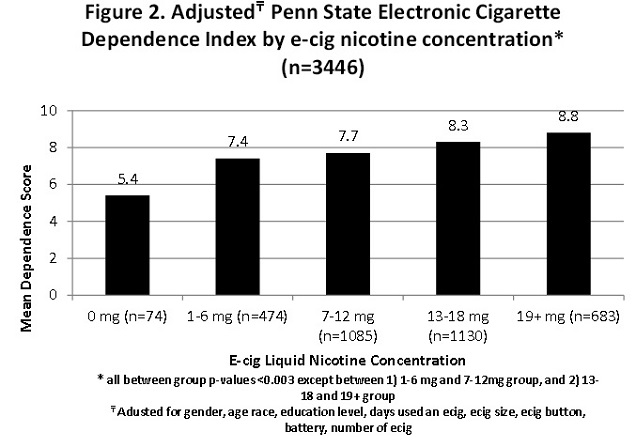
One of the most annoying criticisms of vapers is: “you’re still addicted!” Firstly, it seems like scraping the bottom of the barrel – after obviously having to accept the vast harm reduction potential, it’s a sign that the person is looking for anything to justify their opposition. Most importantly, though, vapers were already addicted to nicotine! We haven’t gained an addiction; we’ve just drastically reduced the harm associated with it. Critique on the basis of some bizarre moral crusade against addiction is pointless, especially if the person saying it happens to drink coffee every day. However, none of this stops the argument from re-surfacing. Thankfully, though, there’s plenty of reason to believe e-cigarettes are actually less addictive than tobacco cigarettes, and a new study has provided more evidence in favor of that hypothesis. In short, this study provides hard data to counter these faux-moral addiction-based critiques.
Summary
- Researchers developed a new scale for nicotine dependence, which was adapted to suit vapers, and put it to the test in a group of over 3,600 ex-smoking vapers.
- The study found that vapers were much less dependent on e-cigarettes than they’d previously been on cigarettes, with lower scores on the dependence scale (going from an average of 14.5 to 8.1 on the scale) and much lower rates of reported withdrawal symptoms and cravings.
- Using higher nicotine levels and later-generation devices was associated with greater e-cig dependence, but this was still much lower than past cigarette dependence.
- The less addictive nature of e-cigs was assumed to be a result of reduced nicotine delivery from e-cigs in comparison to cigarettes.
- In addition to the points covered in the paper, MAOIs are present in cigarettes but not in e-cigarettes, and these have been demonstrated to increase the addictive properties of nicotine.
What They Did – Developing a New Measure of Nicotine Dependence
The researchers aimed to test the dependence of ex-smoking vapers using their newly developed Penn State Cigarette Dependence Scale. The study (link to abstract; full text is paywalled) discusses the various methods used to measure nicotine dependence, in particular the Fagerstrom Test for Nicotine Dependence, the Heaviness of Smoking Index, the Wisconsin Inventory of Smoking Dependence Motives and the Hooked on Nicotine Checklist. These all have positives and negatives, and the researchers used the most predictive elements (such as number of cigarettes per day and time from waking to smoking) from them to create the new scale for dependence, which can easily be adapted to suit other forms of nicotine consumption such as e-cigarettes.
Initial tests of the new scale showed that it successfully predicted difficulty in quitting, and after clarifying the question about number of times used per day it was adapted for e-cigarettes (taking one “use” as about 15 puffs or lasting around 10 minutes). In the present study, they administered a questionnaire to 3,609 ex-smoking vapers, recruited from various websites (including the E-Cigarette Forum), asking about their current e-cigarette use and past smoking to determine their dependence on vaping and past dependence on smoking. They assumed that vapers who used higher-nicotine liquids and those who’d vaped for longer would be more dependent, but questions were also included about the type of e-cigs used and other characteristics.
What They Found –Vapers are Less Dependent Than Smokers
The researchers found that while vapers used their e-cigarettes as much as they used to smoke, their overall score on the new index was much lower than when they were smokers – down from 14.5 to 8.1 – and their individual scores on each item were also lower. As smokers, over 90 percent reported strong withdrawal symptoms and urges to smoke, but as vapers just 25 to 35 percent reported comparable symptoms. Additionally, around 41 percent of respondents used to wake up in the night to smoke, but just 6.8 percent woke up in the night to vape, and their average time from waking to smoking (or vaping) increased from of 27 to 45 minutes.
They also identified several characteristics that are associated with a higher level of dependence on e-cigarettes, including being female, white, not having a college degree, being older, having been a vaper for a longer time, using a non cig-a-like manual model (only 13 percent of respondents used a cig-a-like) and using a higher nicotine e-liquid. Higher prior dependence on cigarettes was also associated with higher levels of e-cigarette dependence.
When the researchers controlled for other relevant variables, the strength of nicotine in the e-liquid used was still a significant predictor of dependence, as you would suspect. Those using 0 nicotine liquids were much less dependent than those consuming nicotine but less than (or equal to) 12 mg/ml, and these people in turn were less dependent than those using higher than 12 mg/ml liquids.

One possible source of bias in the research was the fact that many of the respondents were recruited from e-cigarette websites, and it could be that they underestimated their dependence on vaping in order to “support the cause,” so to speak. The researchers asked questions about previous advocacy activities to determine whether this impacted results, and found that entering this into the model didn’t change the findings. Most tellingly of all, those who’d previously advocated for e-cigs (42 percent of the sample) actually had higher dependence scores than those who hadn’t, so it’s highly unlikely that they underestimated their dependence. In addition, the relevant questions were spread throughout the long questionnaire (among over 120 other questions), so they may not have even been able to identify which ones were important.
Why are E-Cigarettes Less Addictive Than Cigarettes?

The findings definitely paint a positive picture for e-cigarettes in terms of dependence, but the crucial question to ask is what makes them less addictive. The main explanation for this, as you may expect, comes down to the nicotine levels. Research shows that later-generation e-cigarettes are more effective at nicotine delivery than cig-a-like models, but that these are still less effective at nicotine delivery than a cigarette. The finding that those using later-generation devices and those using higher nicotine levels were more dependent supports this explanation, and it also may explain why similar levels of use produced less dependence when vaping. Notably, even when the most dependent vapers (using later-gen models with high nicotine levels for over a year and a half) were analyzed, they were still much less dependent on vaping than they had been on smoking.
There are some limitations to the findings, though. The main one is the retrospective nature of the cigarette dependence reporting, but other research (on the more widely-used Fagerstrom test) shows that similar results are of acceptable reliability. Further research, also incorporating objective biomarkers of nicotine intake, should be able to clarify this. Additionally, it’s worth noting that this scale – although composed of the best parts of other scales – is technically new, so it may not be as reliable as it seems from this study.
However, there is another factor (not mentioned in the paper) which may make cigarettes more addictive than e-cigarettes: monoamine oxidase inhibitors (MAOIs). Basically, you can think of dopamine as the main addiction neurochemical in the brain, serving as the “reward” that keeps you coming back for more (it’s more nuanced than this, but it gives the core idea), and MAOIs have the effect of preventing the removal of dopamine (along with other chemicals) and thus increasing its concentration. These chemicals are among the multitude of components in cigarette smoke, and are not found in e-cigarettes. This is likely to be a factor in why e-cigs are less addictive, and MAOIs have been shown to increase nicotine consumption in rats and have been considered to help with the development of better stop-smoking medicines.
Lead researcher on the study, Jonathan Foulds, commented that “We might actually need e-cigarettes that are better at delivering nicotine because that's what's more likely to help people quit,” echoing similar comments made by researcher Jean-Francois Etter at the 2013 E-Cigarette Summit. In short, with e-cigarettes at a disadvantage in terms of nicotine delivery and addictive ingredients, those of the very reasonable opinion that e-cigarettes should be supported to maximize quitting smoking and reduce harm are starting to question whether or not we need to make e-cigs more addictive. It might seem counter-intuitive (and borderline unthinkable in the current fear-soaked climate regarding e-cigs), but it’s an interesting point that would receive very serious consideration in a more logical world.
Conclusion
So it turns out that we vapers have already reduced our addiction. The anti-addiction elements of opposition to e-cigarettes have always been particularly weak, but this study makes them even weaker. If we’ve learnt anything from the past half-decade, it’s that this won’t stop people making such comments (as with the widely debunked “gateway” hypothesis), but it’s another point that strengthens the case for e-cigarettes. We’re addicted, yeah, but not as much as we would have been otherwise.

